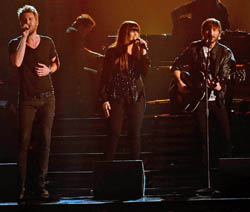Brett “Scoop” Blanden is big on the basics. A Berklee College of Music alum and former manager of Ocean Way Recording in Nashville, his ongoing success as front of house engineer with Lady Antebellum is rooted in a belief that if you never lose sight of the fundamentals, the sum of your efforts will always bear fruit.
“If you stop and think about it, it’s easy to understand why some can literally get lost in their own mix,” Blanden said recently right before a bus ride to his next gig with Lady A. “Sonic excellence occurs when you capitalize on the best opportunities for reinforcing the sound that’s already being created onstage. Do that, and then you don’t have to work so hard the rest of the time.
“Having EQ at your disposal allows you to simply fit the final pieces in your mix together better,” he continues. “You’re not using it so much for damage control. Mics should be chosen collectively to paint an honest picture of the performance.”
His primary goal with his microphone approach is straightforward: capture the true sound of what’s occurring onstage, allowing the musicians themselves to help build the proper tone, texture, and every other nuance of the performance. In turn, monitor engineers don’t have to make a setting change or move faders, snapshots don’t have to be built at front of house, and everyone—artists and engineers alike—is free to focus on the artistic side of their efforts.
More Pop/Rock
The trio out front forming the nucleus of Lady Antebellum—Charles Kelley, Dave Haywood, and Hillary Scott—are supported onstage by a band including veteran Nashville session drummer Chad Cromwell, bassist Dennis Edwards, and guitarists Jason “Slim” Gambill and Clint Chandler.

“While the vocal blend is essential, I wouldn’t call this a vocal-heavy show,” Blanden relates. “On the other hand, it’s fair to say this is a well-mixed show. I approach it in more of a pop/rock fashion, but not like a Vegas act where you barely get to hear the band. Vocals are on top and very intelligible, and I try to keep my vocal blend available at all times. Vocal mics are vital to our sound, all of which use Sennheiser MD 5235 capsules on this tour.”
Blanden feels that the MD 5235 capsule is exceptionally well-suited for capturing Scott’s upper midrange—“better than most I’ve heard,” he says. Conversely, the low-mid performance of the 5235 works so well with Kelley’s voice that very little EQ is required ever. The mic’s pattern is great for all concerned as well, and how it’s perceived in everyone’s in-ear monitors is as realistic and natural as the sound Blanden creates in the house.
There are six vocal mics onstage, five of which are left open all the time. “Some people gate their vocal mics,” Blanden observes. “But this is a live show, and I’m a live sound reinforcement engineer. I come to this post with the mentality that if what we have is wrong onstage, it will translate into being wrong out front. You have to get it right—choose the correct amps for your guitars, a good drum kit that’s in-tune and has the tonality required. Get it right at the source, and you’ll be working with a tonal picture that you can easily reinforce with the PA.”















